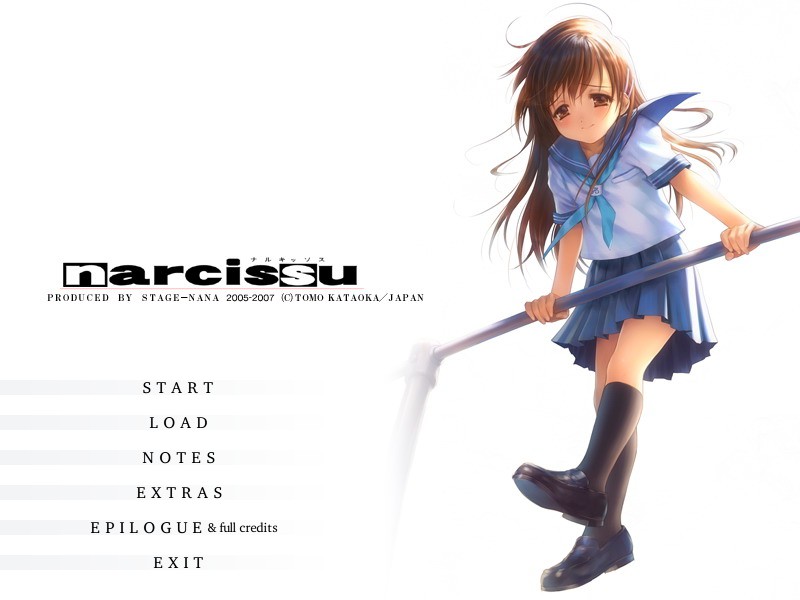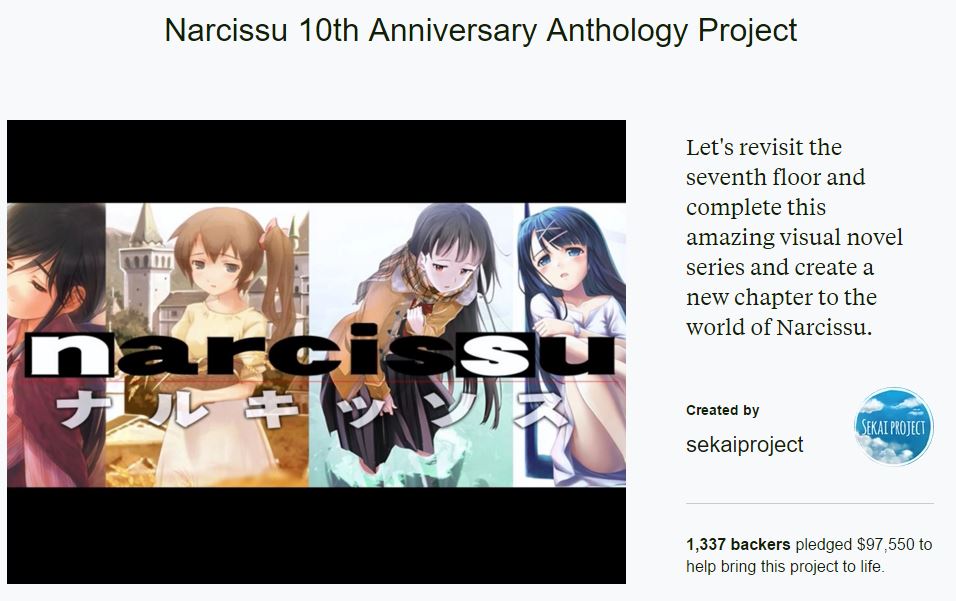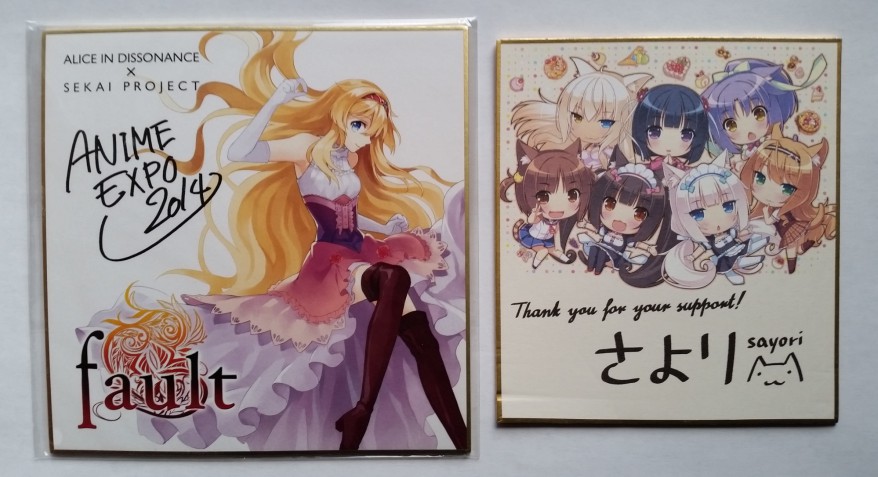Sekai Project have made quite a name for themselves in the visual novel space in just a few years. They’ve also gained a reputation for their liberal use of Kickstarter to fund projects. Of course, those most diehard fans recognize that only around 10% of their titles in total ever made the jump to crowdfunding by their own hand (many projects they’re publishing, however, have also gone the Kickstarter route). In any case, the latest project of theirs was the Narcissu 10th Anniversary Anthology Project. All told, this would be bringing not one but four visual novels in the much-loved Narcissu series to the west. Those titles are as follows: A Little Iris, Himeko’s Epilogue, Sumire, Zero.
Sekai Project initially launched a Prefundia to test the waters with their upcoming Narcissu campaign and get feedback from fans. At that time, they had set the funding goal at $150,000 with stretch goals at $200,000, $250,000, and $500,000. Why was the price so high? Well, it’s not as if that is something new for the company. The Clannad campaign required $140,000 and The Grisaia Trilogy sat even a bit higher at $160,000. Of course, visual novel fans will note that those are much longer games to play through when compared to these Narcissu titles. You see, what was actually the case is that Sekai Project were helping to pay for some actual game development — not just localization. Many folks glossed over this fact because it was not explained very much on the page.
When Narcissu 10th Anniversary Anthology Project launched on Kickstarter proper it came with a brand new funding goal: $75,000. Yes, you read that right. At launch, they cut their previously-estimated goal in half. How?! Sekai Project shared a terse explanation of the different prices with the following comment: “…we’ve spent the $60,000 and found an additional funding source before turning to Kickstarter.” Due to business dealings and all that, it appears backers won’t be told who or what this funding source is, but it’s thanks to Sekai Project’s own investment that they were able to cut the goal down to fit in line with expectations, as well as increase the likelihood of its success.
At the time of launch, Narcissu offered five stretch goals. The three from Prefundia returned, although $500,000 was finally revealed to be for a 30 minute – 1 hour long OVA. In addition, two new tiers were added at $100,000 and $150,000 to make up the space that the lowered goal created. The lowest brought in the potential of the “1980” short story while the next goal offered a mini-shikishi. For the uninitiated, this is basically a small square of high-quality cardboard stock with an image and artist’s signature on the front. By the end of the campaign on November 25, Sekai Project did not reach any of their stretch goals, but Narcissu was fully funded.

Narcissu 10th Anniversary Anthology Project raised $97,550 via Kickstarter (and potentially more via PayPal). For those who missed the campaign totally, it actually was not a powerful success that many expected. After netting $20,000 in the span of a day, the project stalled hard. Yes, almost all Kickstarters tend to have a huge lull, but not Sekai Project. At least, not in their earlier projects. Their first five visual novel Kickstarter campaigns all found projects funded within the first two days. Sure, some projects like World End Economica -Complete- were asking for far smaller goals ($22,000). But others, like the aforementioned Grisaia Trilogy still saw outrageously fast success, even despite drama with Kickstarter that pulled many pledges.
Success got a little less immediate with their next two campaigns: Memory’s Dogma and The Human Reignition Project. Still, both were funded within the first week of going live on Kickstarter. Narcissu took 28 days of a total 31 day funding period. This, coming on the heels of failed project Witch Boy Magical Piece, is a bit disturbing. There was a time when people felt that Sekai Project could not fail at Kickstarter. In my assessment of Witch Boy Magical Piece’s failure, my belief was that Sekai Project themselves had also fallen prey to that belief which led to a less than stellar campaign presentation (among many other variables).
What was it that kept pledges so tame for Narcissu compared to the out of the gate successes of previous Sekai Project visual novel Kickstarters? It’s hard to pin down exactly why. After all, Narcissu is a pretty well known entity for genre fans. Not only that, but Narcissu 1st & 2nd has been available as a free to play download on Steam for a while now. If nothing else, that should have helped expand awareness of the series to even more gamers than before. So, in my view, it is not that the product was unknown or unattractive to visual novel fans in and of itself which caused a tepid funding response. It’s possible the lessened reaction is due to people simply tiring of Sekai Project Kickstarter after Kickstarter when so many promises are still pending (games not yet complete, rewards not yet shipped).
One complaint many fans raised was that Narcissu 10th Anniversary Anthology Project launched at a bad time. This is because an incredibly high-profile visual novel project was currently live at the time: Muv-Luv. Muv-Luv, which had launched on September 24, ended on November 3. Narcissu launched on October 26, leaving about a week of overlap between the two. This means that instead of getting all the visual novel attention to themselves, Sekai Project were forced to play second fiddle to the explosive campaign on Muv-Luv Team’s hands. By the end, that project raised $1.2 million — far more than any other visual novel on Kickstarter from any company. With so much excitement focused on that one single title, it was harder for Narcissu to break in.
Not only that, but you’re playing to an audience which is already strapped for cash. 2015 has seen an impressive amount of visual novels come to Kickstarter, and many fans have done their best to pledge to many of them. But when you have two campaigns in such close proximity it can often become much harder to warrant yet another pledge. I’ll admit, I wanted to back both projects, but in the end only went with the $150 tier of Muv-Luv. The timing just didn’t work out at all. Beyond the overlap, it’s also a pretty tough time to spend money for myself instead of others as the holiday season rapidly approaches. It’s possible this may have also had an affect on backing behavior for some other folks.
Another issue with the weak funding trend may very well be psychological. After the first week, funding stalled right around $40,000. Funds were coming in daily, but not at all at the clip required to make it. By the second week, even Sekai Project were publicly acknowledging the potential failure of the Kickstarter. They revealed that, if it failed, there would be no chance for physical goods. However, with all the money they’d already put into the games, there’d still likely be hope for everything to eventually release. Words like this often seem to cause backers to lose that feeling of intensity. After all, why back if a title will still come out anyway? For whatever reason funds slowed to a crawl. That’s all it took to make backers feel more reticent to back, until Sekai Project started making new, exciting announcements.
On November 4, they let people vote on the item to be included in a new reward tier. But other than that there was nothing particularly exciting going on with the updates page. Even that didn’t matter for many since the new tier would be in the $200 range. Things started to get interesting on November 13 — a week prior to the Kickstarter closing. At this point, Sekai Project announced that 1980 would be added so everyone would be able to enjoy it. Wait, the same 1980 which had been used as the one addition at the $150,000 stretch goal? Yep. On November 15, things got even cooler (at least from my perspective) as Chris Huelsbeck was added as a composer.
Now, I honestly only know his work from the days of retro gaming, and as such found it a bit of an odd choice. However, the track clip provided in the update shows Huelsbeck is skilled in all sorts of types of music. Shortly after, Hiroki Kikuta was also announced as a guest composer. Basically, things were really heating up in the update department in this last week. My question is why did they wait until the last week to fight so hard to ensure Narcissu was funded? Why weren’t these awesome tidbits revealed earlier on? Yes, I know deals take time to prepare, but it’s my view that a total lack of compelling updates harmed Narcissu’s early success quite a bit. Luckily, all this refreshed attention and news helped propel the game past its Kickstarter goal in the final 3 days.
We’re not quite at the end of the story (or my analysis) however. You see, there’s a few more things that I still feel at odds with. Once the project met its goal, another update went out to backers to say thank you, announce PayPal pledges had opened up, and that everyone who got a physical item would receive a free mini-shikishi. This is actually the same mini-shikishi that was touted as the $150,000 stretch goal’s item. My issue with this action (and the inclusion of 1980, which was also a stretch goal) is not with the fact that Sekai Project gave fans more than they expected. In fact, that’s a very cool thing to do!
The problem from my perspective is that these items in and of themselves were hardly compelling enough to get people pushing toward stretch goals at all. There’s no doubt that a new side story is pretty neat and all, but Sekai Project removed it as a potential lure when they gave it to everyone at the start of the final week of funding. And heck, I don’t know about you, but a mini-shikishi is hardly an enthralling reason to pledge beyond my means. And that’s coming from someone who already has two or three of these items from Sekai Project. They’re neat and all, but not a huge draw. After both these low stretch goals were gone, that left only ones at $200,000+. The chances of attaining those heights in a final week just weren’t very likely, even though they did include potentially awesome additions higher up.
Sort of. At $200,000, the goal was “other platforms (We’re researching what’s feasible now).” What the heck does that honestly mean? Sekai Project is known for offering Vita copies of their games, even though they’ve still not gotten their first visual novel onto PlayStation Network just yet. It appears this statement was written in order to avoid saying “Vita” specifically, and then receiving the ire of those players (as this is exactly what has happened in previous projects due to Vita copies being MIA long term while Steam versions are released). But what else would this mean aside from Vita? The only thing I can think of is mobile, as very few people dare brave bringing visual novels to home consoles. It would also be darn unlikely for Sekai Project to test the waters with yet another platform after all the trouble they’ve had just getting past Sony. Whatever they meant by this statement, not explicitly stating Vita lessened the Vita crowd’s need to back, even though this was probably a smart move from a potential grief standpoint.
Now that the campaign is complete with nearly $100,000 in funding, Sekai Project can feel secure in proceeding onward with each title. At the moment, the digital release of Himeko’s Epilogue is still planned for “late November.” However, their Steam Greenlight page somehow took until today (of this writing) to be greenlit. Not sure why they launched the Greenlight right near the of the campaign instead of at launch (as is typically common for Kickstarters). Sure, they may have feared failure, but that’s never stopped folks from running a Greenlight page before. The Steam Community is currently cluttered with games that will never be made. Whatever the case, this success means they can get Himeko’s Epilogue into Steam before the end of November, provided they’re ready to meet that date.
This was one heck of a Kickstarter. The Narcissu 10th Anniversary Anthology Project had so much going on that it simply required a deeper look. Now that you’ve read through this all, what are your thoughts? Did you back the project? If so, why and if not, why not?








I ended up not backing this project, as Sekai simply couldn’t have picked a worst time to launch this campaign. I will give them credit for turning it around though, still can’t believe they exceeded their funding goal.
P.S. In the end the factors that hurt this campaign were:
-Starting a Prefundia on such short notice
-Running it at the same time as MuvLuv
-Lack of awareness towards the campaign
-Sekai Project bad PR with some people over the cropping of “G-senjou no Maou – The Devil on G-String”
-Sekai Project bad PR over there fallout with “Winged Cloud, plus WC eventual transition over to Mangagamers sphere.